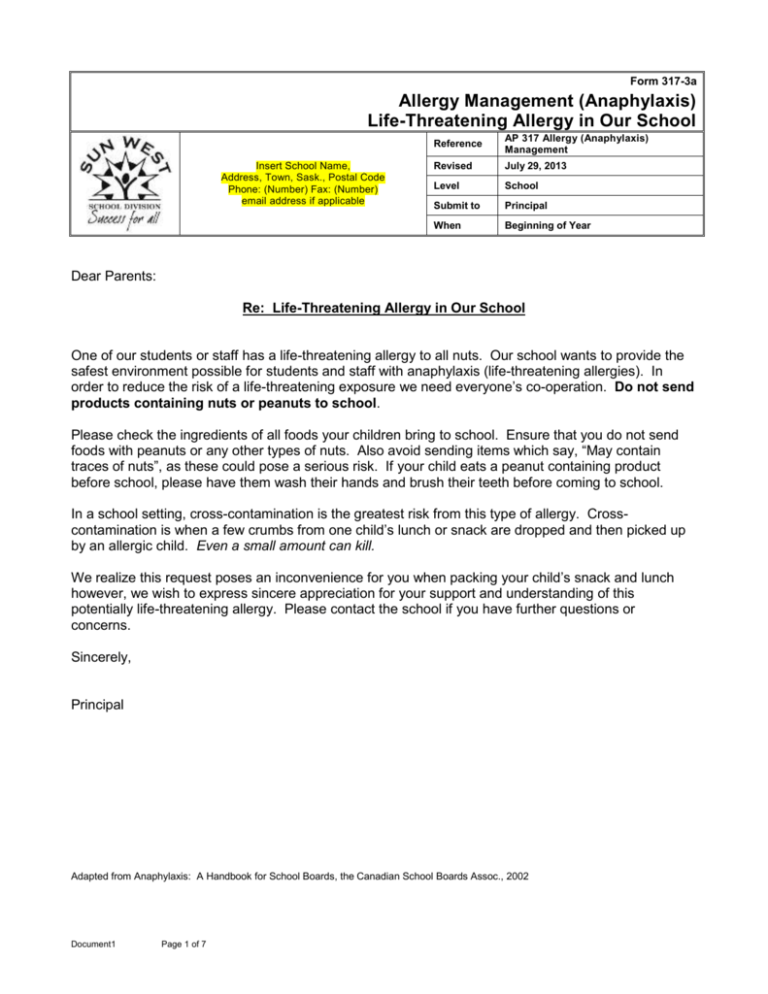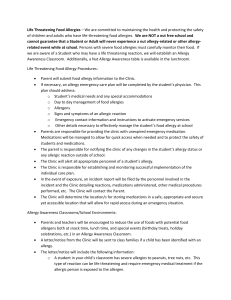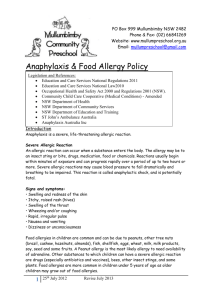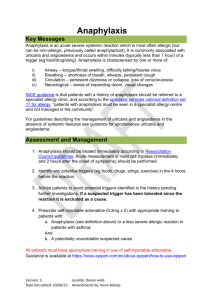317-3a-317-3g Allergy Management (Anaphylaxis) Letter
advertisement

Form 317-3a Allergy Management (Anaphylaxis) Life-Threatening Allergy in Our School Insert School Name, Address, Town, Sask., Postal Code Phone: (Number) Fax: (Number) email address if applicable Reference AP 317 Allergy (Anaphylaxis) Management Revised July 29, 2013 Level School Submit to Principal When Beginning of Year Dear Parents: Re: Life-Threatening Allergy in Our School One of our students or staff has a life-threatening allergy to all nuts. Our school wants to provide the safest environment possible for students and staff with anaphylaxis (life-threatening allergies). In order to reduce the risk of a life-threatening exposure we need everyone’s co-operation. Do not send products containing nuts or peanuts to school. Please check the ingredients of all foods your children bring to school. Ensure that you do not send foods with peanuts or any other types of nuts. Also avoid sending items which say, “May contain traces of nuts”, as these could pose a serious risk. If your child eats a peanut containing product before school, please have them wash their hands and brush their teeth before coming to school. In a school setting, cross-contamination is the greatest risk from this type of allergy. Crosscontamination is when a few crumbs from one child’s lunch or snack are dropped and then picked up by an allergic child. Even a small amount can kill. We realize this request poses an inconvenience for you when packing your child’s snack and lunch however, we wish to express sincere appreciation for your support and understanding of this potentially life-threatening allergy. Please contact the school if you have further questions or concerns. Sincerely, Principal Adapted from Anaphylaxis: A Handbook for School Boards, the Canadian School Boards Assoc., 2002 Document1 Page 1 of 7 Form 317-3b Allergy Management (Anaphylaxis) Visitors To Our Schools With Life Threatening Allergies Insert School Name, Address, Town, Sask., Postal Code Phone: (Number) Fax: (Number) email address if applicable Reference AP 317 Allergy (Anaphylaxis) Management Revised July 29, 2013 Level School Submit to Principal When As Required Dear Parents: Visitors to our School Re: Life-Threatening Allergies in our School Our school wants to provide the safest environment possible for those with anaphylaxis (lifethreatening allergies) who may be visiting our school for sports or other special events. In order to reduce the risk of a life-threatening exposure we need everyone’s co-operation. Do not send products containing nuts to school. Please check the ingredients of all foods your children bring to school. Ensure that you do not send foods with peanuts or any other types of nuts. Also avoid sending items which say, “May contain traces of nuts”, as these could pose a serious risk. If your child eats a peanut/nut containing product before school, please have them wash their hands and brush their teeth before coming to school. In a school setting, cross-contamination is the greatest risk from this type of allergy. Crosscontamination is when a few crumbs from one child’s lunch or snack are dropped and then picked up by an allergic child. Even a small amount can kill. We realize this request poses an inconvenience for you when packing your child’s snack and lunch however, we wish to express sincere appreciation for your support and understanding of this potentially life-threatening allergy. Please contact the school if you have further questions or concerns. Sincerely, Principal Adapted from Anaphylaxis: A Handbook for School Boards, the Canadian School Boards Assoc., 2002 Document1 Page 2 of 7 Form 317-3c Allergy Management (Anaphylaxis) Nut Alert: Reduce the Risk! Reminder Insert School Name, Address, Town, Sask., Postal Code Phone: (Number) Fax: (Number) email address if applicable Reference AP 317 Allergy (Anaphylaxis) Management Revised July 29, 2013 Level School Submit to Principal When As Required Dear Parent or Guardian of _________________________________, Nut Alert: Reduce the Risk! Reminder Today at lunch or snack, we noticed that your child brought an item containing nuts. This note is just a reminder that we are a “Nut Alert” School. This means that students are not to bring any nut containing food items to the School. We are taking this step to ensure a safe environment for students with life-threatening allergies to peanuts and other nut products. Please feel free to contact the school if you have questions or concerns. Thank you for your co-operation, Sincerely Principal Adapted from Anaphylaxis: A Handbook for School Boards, the Canadian School Boards Assoc., 2002 Document1 Page 3 of 7 Form 317-3d Allergy Management (Anaphylaxis) Life-Threatening Allergies - Reminder Insert School Name, Address, Town, Sask., Postal Code Phone: (Number) Fax: (Number) email address if applicable Reference AP 317 Allergy (Anaphylaxis) Management Revised July 29, 2013 Level School Submit to Principal When As Required Dear Parents: RE: Life-Threatening Allergies – Reminder The children in our school with severe peanut and nut allergies, and their families would like to join me in thanking you for your understanding and cooperation as a result of the request to avoid sending peanut and nut products to school. There has been a reduction in the number of peanut and nut products brought to school in snacks and lunches, and we would like to thank you for continuing not to send these products to school with your child. Since even a small amount of the allergic substance can cause a life-threatening reaction, keeping it out of the school is our best method of preventing a serious reaction at school. If your child accidentally brings a food to school containing peanut or nut products, please ask the child to let the teacher know. Thank you again for your cooperation in this important issue. Sincerely, Principal Adapted from Anaphylaxis: a Handbook for School Boards, the Canadian School Boards Assoc., 2002 Document1 Page 4 of 7 Form 317-3e Allergy Management (Anaphylaxis) Newsletter Article 1 Insert School Name, Address, Town, Sask., Postal Code Phone: (Number) Fax: (Number) email address if applicable Reference AP 317 Allergy (Anaphylaxis) Management Revised July 29, 2013 Level School Submit to Principal When As Required NUT ALERT: REDUCE THE RISK! We have students in our school with a severe life-threatening allergy (anaphylaxis) to nuts, peanuts and products containing nuts or peanuts. Exposure to even a tiny amount such as peanut butter on the hands of a student or teacher who then touches a door knob, computer, water faucet, water fountain or other article that is then touched by a student severely allergic to peanuts could be enough to cause a severe reaction. Without immediate emergency medical assistance this reaction could result in loss of consciousness and death. The school has established emergency plans for the students. Part of this plan is to establish a safe environment for all students. Therefore, we are requesting that our school be Nut Alert: Reduce the Risk! Parents and teachers should avoid including nuts, peanuts and products containing nuts or peanuts in lunches or snacks or to the school. There are a number of alternatives to peanut butter sandwiches included in this newsletter. NUT ALERT: REDUCE THE RISK! GOAL: We hope to establish and maintain, but cannot guarantee: a school, school environment, and buses free of nuts and nut products Thank you for your assistance with this important matter. (Adapted from West Royalty Elementary School Newsletter, PEI) Document1 Page 5 of 7 Form 317-3f Allergy Management (Anaphylaxis) Newsletter Article 2 Insert School Name, Address, Town, Sask., Postal Code Phone: (Number) Fax: (Number) email address if applicable Reference AP 317 Allergy (Anaphylaxis) Management Revised July 29, 2013 Level School Submit to Principal When As Required NUT ALERT: REDUCE THE RISK! SCHOOL LUNCHES The incidence of life-threatening allergies to nuts and peanuts has risen dramatically among children. As a result, our schools have adopted a Nut-Alert: Reduce the Risk strategy. For this reason we ask no nuts or peanuts, nut or peanut butters or products that contain peanuts or nuts be sent to school. When sending packaged products, parents are asked to read the labels to be sure that none of these foods are among the ingredients listed. There are many healthy alternatives to nut and peanut products that children enjoy. Below are a few examples: Sandwich fillings can include protein sources such as lean meat, poultry or fish, egg salad, beans or cheese. Use whole grain tortilla wraps, pita bread or bagels for variety. Try a spread of low fat cream cheese with grated carrots and chopped pineapple on a tortilla. Roll and cut into pinwheel shapes. Burritos made with bean and vegetable mixtures are also popular. For a main course salad, combine cut up vegetables with whole grain pasta or rice, one of the protein sources mentioned above and a small amount of salad dressing. For non-allergic children, nuts and peanuts and products containing nuts and peanuts are nutritious foods that can be enjoyed at home. When children have eaten nut or peanut products prior to coming to school, they should be sure to wash their hands and brush their teeth. Following allergy strategies carefully is critical. It helps to create a safe environment for all students. Your co-operation is appreciated. WRITTEN BY THE PUBLIC HEALTH NUTRITIONISTS OF SASKATCHEWAN Distributed by the School Nutritionist, Food for Thought Project, 765-6609 Document1 Page 6 of 7 Form 317-3g Allergy Management (Anaphylaxis) Newsletter Article 3 Insert School Name, Address, Town, Sask., Postal Code Phone: (Number) Fax: (Number) email address if applicable Reference AP 317 Allergy (Anaphylaxis) Management Revised July 29, 2013 Level School Submit to Principal When As Required Nut Alert Lunch Ideas When one or more students in a school have an allergy to nuts or peanuts, the whole school may need to become Nut Alert: Reduce the Risk! This means other students will be asked to not bring lunch items containing nuts or peanuts. If your child’s favourite sandwich is peanut butter and jelly, what other choices do you have? Meat sandwiches made with roast beef, chicken, turkey, pork, ham, tuna, salmon, egg or sardines. Vegetarian sandwiches made with avocado, cream cheese, cucumbers, tomato, cheese and/or lettuce. Keep it interesting by using wraps, pitas and buns instead of just bread. Bagels and low fat cream cheese or cheese spread and fruit. Soup – ideally tomato or broth-based soups with vegetables, lentils, split peas and/or beans. Check the label to ensure the soup does not contain peanut oil. Send to school in a thermos or reheat in the microwave. Pizza bagels, buns or English muffins. Quesadillas, soft tacos or burritos – flour tortilla topped with cheese, meat or beans and vegetables. Serve with salsa and low-fat sour cream or plain yoghurt. Send to school cold or reheat in the microwave. Cheese and crackers. Read labels carefully to make sure the crackers have not been in contact with peanuts or peanut oil. Hamburger and potato salad. Chili and a bun. Pasta and sauce. Cereal (dry or with milk). Read labels carefully to make sure the cereal has not been in contact with peanuts or peanut oil. Note: Children with peanut allergies should never take food from another child, even if they think the food does not contain nuts or peanuts. Read labels regularly because manufacturers often change the ingredients in their products. WRITTEN BY THE PUBLIC HEALTH NUTRITIONISTS OF SASKATCHEWAN More Information: Allergy/Asthma Information Association http://www.aaia.ca/ Anaphylaxis Canada http://www.anaphylaxis.org/ Safe4kids http://www.safe4kids.ca Hand washing posters: http://www.publichealth.va.gov/infectiondontpassiton/detail_hand.htm www.nfsmi.org/Information/handwashing/int_symbol070804.pdf http://healthymeals.nal.usda.gov/nal_display/index.php?info_center=14&tax_level=3&tax_subject=231&topic_id=1198&level3_id=5075 Document1 Page 7 of 7



